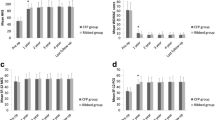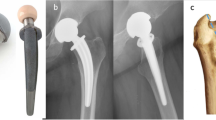Abstract
The objective of this study was to follow-up long term (5–12 years) patients with total hip arthroplasty with the collum femoris preserving prosthesis to evaluate clinical outcome and potential complications. Forty-six of 152 patients who underwent this procedure between September 2000 and September 2012 were followed up. The average follow-up time was 7.6 years, and assessed were radiographs, Harris score, limb length, hip function, and complications. Six patients had perioperative complications including five cases of femoral shaft fracture and one case of dislocation 1 week after the operation. No infections of the surgical site, no deep venous thrombosis or pulmonary embolism were observed. The last recorded Harris hip score improved from a preoperative average of 41.2 (range 17–60) to an average of 82.3 (74–96), with the score >80 in 38 patients, 70–80 in six patients, and <70 in two patients. Radiolucent lines were found on radiographs in two patients with acetabular prosthesis and one patient with femoral prosthesis. The remainder of patients had satisfactory positions of acetabular and femoral stem prostheses with no loosening or subsidence, and a good condition of femoral neck. Total hip arthroplasty with the collum femoris preserving prosthesis is a good option for younger patients who need prosthesis revision. This arthroplasty achieves satisfactory long-term effectiveness.
Similar content being viewed by others
Abbreviations
- THA:
-
Total hip arthroplasty
- CFP:
-
The collum femoris preserving prosthesis
References
Li, H., Wei, W., & Yuan, Y. (2011). Clinical and radiographic results of primary total hip arthroplasty: An over-six-year follow-up. Chinese Journal of Joint Surgery, 5, 555–560. in Chinese.
Hungerford, M. W., Mont, M. A., Scott, R., Fiore, C., Hungerford, D. S., & Krackow, K. A. (1998). Surface replacement hemiarthroplasty for the treatment of osteonecrosis of the femoral head. Journal of Bone and Joint Surgery American Volume, 80, 1656–1664.
Martell, J. M., Pierson, R. H, I. I. I., Jacobs, J. J., Rosenberg, A. G., Maley, M., & Galante, J. O. (1993). Primary total hip reconstruction with a titanium fiber-coated prosthesis inserted without cement. Journal of Bone and Joint Surgery American Volume, 75, 554–571.
Devane, P. A., & Horne, J. G. (1999). Assessment of polyethylene wear in total hip replacement. Clinical Orthopaedics and Related Research, 1999, 59–72.
Makela, K. T., Eskelinen, A., Pulkkinen, P., Paavolainen, P., & Remes, V. (2011). Results of 3,668 primary total hip replacements for primary osteoarthritis in patients under the age of 55 years. Acta Orthopaedica, 82, 521–529.
Biggi, F., Franchin, F., & Lovato, R. (2004). DEXA evaluation of total hip arthroplasty with neck-preserving technique: 4-year follow-up. Journal of Orthopaedics and Traumatology, 2004, 156–159.
Callary, S. A., Campbell, D. G., Mercer, G. E., Nilsson, K. G., & Field, J. R. (2012). The 6-year migration characteristics of a hydroxyapatite-coated femoral stem: A radiostereometric analysis study. Journal of Arthroplasty, 27, 1344–1348.
Back, D. L., Dalziel, R., Young, D., & Shimmin, A. (2005). Early results of primary Birmingham hip resurfacings. An independent prospective study of the first 230 hips. Journal of Bone and Joint Surgery British Volume, 87, 324–329.
Hooper, G. J., Rothwell, A. G., Stringer, M., & Frampton, C. (2009). Revision following cemented and uncemented primary total hip replacement: A seven-year analysis from the New Zealand Joint Registry. Journal of Bone and Joint Surgery British Volume, 91, 451–458.
Zhao, F., & Li, Z. (2009). Prevention of dislocation after total hip replacement. Orthopedic Journal of China, 17, 674–676. in Chinese.
Huang, Y., Kong, R., & Fang, S. (2009). Analysis and prevention of dislocation after total hip replacement. Orthopedic Journal of China, 17, 333–335. in Chinese.
Thomsen, M. N., Jakubowitz, E., Seeger, J. B., Lee, C., Kretzer, J. P., & Clarius, M. (2008). Fracture load for periprosthetic femoral fractures in cemented versus uncemented hip stems: An experimental in vitro study. Orthopedics, 31, 653.
Woolson, S. T. (1990). Leg length equalization during total hip replacement. Orthopedics, 1990(13), 17–21.
Turula, K. B., Friberg, O., Lindholm, T. S., Tallroth, K., & Vankka, E. (1986). Leg length inequality after total hip arthroplasty. Clinical Orthopaedics and Related Research, 1986, 163–168.
Author information
Authors and Affiliations
Corresponding author
Rights and permissions
About this article
Cite this article
You, Rj., Zheng, Wz., Chen, K. et al. Long-Term Effectiveness of Total Hip Replacement with the Collum Femoris Preserving Prosthesis. Cell Biochem Biophys 72, 43–47 (2015). https://doi.org/10.1007/s12013-014-0401-y
Published:
Issue Date:
DOI: https://doi.org/10.1007/s12013-014-0401-y




